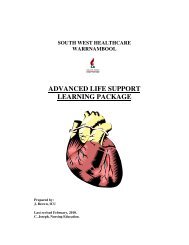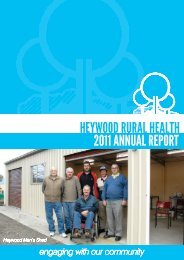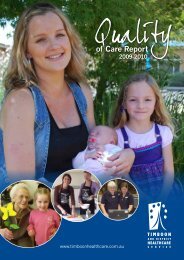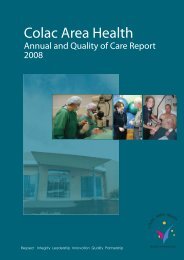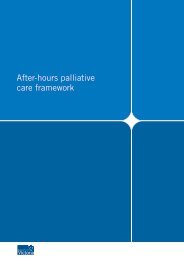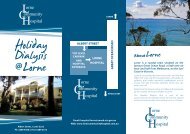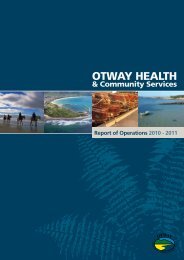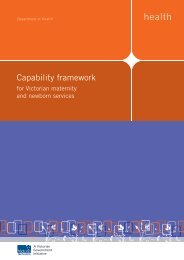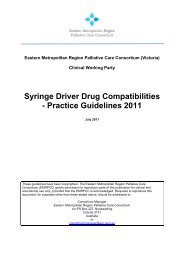Self Directed Learning Package - University of Queensland
Self Directed Learning Package - University of Queensland
Self Directed Learning Package - University of Queensland
- No tags were found...
Create successful ePaper yourself
Turn your PDF publications into a flip-book with our unique Google optimized e-Paper software.
150 • The Palliative Approach ToolkitSayReport your assessmentSigns <strong>of</strong> delirium always need to be reported to a nurse.Be as clear and detailed as possible.Thinking PointWhich <strong>of</strong> the following do you think will get the bestresponse?Careworker to nurse:‘Alfred appears to be confused. He wants to go andcatch chickens. He seems to have become confusedfollowing a urine infection last week’.Is much better than:‘Alfred is confused. You need to see him to sort it out’.DoManage the problemIt may be appropriate to treat the cause <strong>of</strong> delirium (if it isknown). However, at the end <strong>of</strong> life simple measures aimed atmanaging the symptoms may be preferable.Thinking PointImagine you are Alfred. It is night-time and you arelying in your bed. It is dark, no one is around and youare confused, frightened and not sure where you are.You hear noises outside your door that sometimesdisturb you. Perhaps you want to get out <strong>of</strong> bed t<strong>of</strong>ind somewhere better to be.Look at the following lists <strong>of</strong> strategies. Which <strong>of</strong>these measures might help you feel less confusedand anxious?Environmental strategies 11• appropriate lighting• minimise noise especially at night• provide a clock that the resident can see• avoid room or location changes and keep personal andfamiliar objects in view• modify the environment to minimise the risk <strong>of</strong> injurye.g. low bed in the lowest position with cot sides down, bedagainst the wall, potential hazards such as beside tablesremoved.Clinical strategies 11• address anxiety; residents with delirium are <strong>of</strong>ten veryfrightened• manage discomfort or pain• minimise sensory deficits by providing and assisting withhearing and visual aidse.g. clean spectacles and remove wax deposits in hearing aids,check batteries are fresh and hearing aid is turned on• encourage the presence <strong>of</strong> people known to the residente.g. family and friends and regular staff members• reassure and reorientate the resident• explain and reassure the resident and/or family regardingthe possible causes <strong>of</strong> the delirium and describe themanagement plan• avoid use <strong>of</strong> physical restraints• use interpreters and communication aids for residentswith culturally and linguistically diverse needs (CaLD)• promote relaxation and sufficient sleepe.g. assisted by massage and/or encouraging wakefulnessduring the day• minimise use <strong>of</strong> indwelling catheters• medication reviewe.g. cease or reduce all non-essential medications; changeto a different opioid medication; utilise medications to targetagitation or hallucinations.



